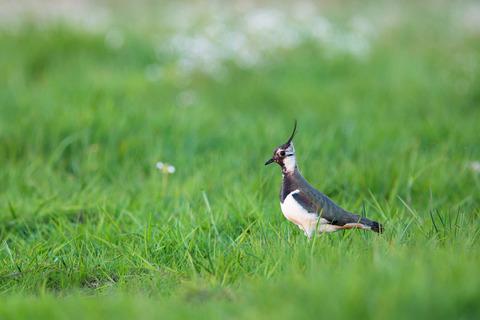当前位置:
X-MOL 学术
›
Anim. Conserv.
›
论文详情
Our official English website, www.x-mol.net, welcomes your feedback! (Note: you will need to create a separate account there.)
Low productivity and unsuitable management drive the decline of central European lapwing populations
Animal Conservation ( IF 3.4 ) Pub Date : 2019-10-10 , DOI: 10.1111/acv.12540 F. Plard 1 , H. A. Bruns 2 , D. V. Cimiotti 2 , A. Helmecke 2 , H. Hötker 2 , H. Jeromin 2 , M. Roodbergen 3 , H. Schekkerman 3 , W. Teunissen 3 , H. Jeugd 4 , M. Schaub 1
Animal Conservation ( IF 3.4 ) Pub Date : 2019-10-10 , DOI: 10.1111/acv.12540 F. Plard 1 , H. A. Bruns 2 , D. V. Cimiotti 2 , A. Helmecke 2 , H. Hötker 2 , H. Jeromin 2 , M. Roodbergen 3 , H. Schekkerman 3 , W. Teunissen 3 , H. Jeugd 4 , M. Schaub 1
Affiliation

|
Abstract Despite the protective measures that have been implemented to increase the productivity of meadow birds, populations are still declining in most breeding and wintering areas. We therefore still do not know how large the protective efforts need to be to curb the decline of the meadow bird populations. By taking advantage of monitoring data from the populations of lapwings in the Netherlands (NL) and one region in Germany [Schleswig-Holstein (SH)], we investigated the demographic drivers responsible for the decline of the populations and evaluated the impact of protective measures. In these populations, some nests are marked with sticks such that they are not destroyed by farming activity. We analyzed the data with integrated population models and show that average demographic rates were similar in the two populations. Retrospective analyses demonstrated that variation in productivity most strongly impacted population dynamics and that its variation was influenced by the local environments. Our results confirmed that low productivity (0.55 and 0.46 fledglings per pairs in SH and NL, respectively) was the main reason for the decline of the lapwing populations. Productivity of 0.76 (SH) and 0.91 (NL) fledglings per pairs would be required to stabilize the populations. The implemented nest protection had a positive effect on nest success, but did not improve chick survival, and consequently the effect on population growth rates remained insufficient. The population growth rate in NL would increase by only 2% if all nests were protected. Our results suggest that protective measures should prioritize the reduction in predation and the improvement of chick habitat by promoting heterogeneous swards combining tall vegetation for hiding and short and open vegetation for foraging.
中文翻译:

生产力低下和管理不当导致中欧田鸡种群下降
摘要 尽管已采取保护措施以提高草甸鸟类的生产力,但大多数繁殖和越冬地区的种群数量仍在下降。因此,我们仍然不知道需要采取多大的保护措施来遏制草甸鸟类数量的下降。通过利用荷兰 (NL) 和德国一个地区 [石勒苏益格-荷尔斯泰因 (SH)] 的田鸡种群的监测数据,我们调查了导致种群下降的人口驱动因素,并评估了保护措施的影响. 在这些种群中,一些巢穴用木棍做标记,这样它们就不会被农业活动破坏。我们使用综合人口模型分析了数据,结果表明两个人口的平均人口比率相似。回顾性分析表明,生产力的变化对种群动态的影响最大,并且其变化受当地环境的影响。我们的研究结果证实,低生产力(SH 和 NL 的每对雏鸟分别为 0.55 和 0.46 只)是田鸡种群下降的主要原因。稳定种群需要每对 0.76 (SH) 和 0.91 (NL) 雏鸟的生产力。实施的筑巢保护对筑巢成功有积极影响,但并没有提高雏鸡的存活率,因此对种群增长率的影响仍然不足。如果所有巢都得到保护,NL 的人口增长率只会增加 2%。
更新日期:2019-10-10
中文翻译:

生产力低下和管理不当导致中欧田鸡种群下降
摘要 尽管已采取保护措施以提高草甸鸟类的生产力,但大多数繁殖和越冬地区的种群数量仍在下降。因此,我们仍然不知道需要采取多大的保护措施来遏制草甸鸟类数量的下降。通过利用荷兰 (NL) 和德国一个地区 [石勒苏益格-荷尔斯泰因 (SH)] 的田鸡种群的监测数据,我们调查了导致种群下降的人口驱动因素,并评估了保护措施的影响. 在这些种群中,一些巢穴用木棍做标记,这样它们就不会被农业活动破坏。我们使用综合人口模型分析了数据,结果表明两个人口的平均人口比率相似。回顾性分析表明,生产力的变化对种群动态的影响最大,并且其变化受当地环境的影响。我们的研究结果证实,低生产力(SH 和 NL 的每对雏鸟分别为 0.55 和 0.46 只)是田鸡种群下降的主要原因。稳定种群需要每对 0.76 (SH) 和 0.91 (NL) 雏鸟的生产力。实施的筑巢保护对筑巢成功有积极影响,但并没有提高雏鸡的存活率,因此对种群增长率的影响仍然不足。如果所有巢都得到保护,NL 的人口增长率只会增加 2%。



























 京公网安备 11010802027423号
京公网安备 11010802027423号